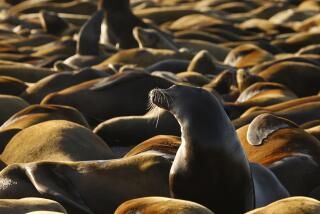Decline of Sea Otters
- Share via
* Re “Decline of Sea Otter Population for 4th Straight Year Baffles Biologists,” July 8: I am surprised that the biologists commenting on the recent decline of the southern sea otter aren’t casting a suspicious eye on the lucrative purple urchin fishery along our coast.
California divers are still shipping tons of these urchins to the Far East, where they are highly prized as a gourmet delicacy. The urchins also constitute a major portion of the dinner plate for the otters and their babies. (Some of the otters eat so many urchins that their teeth take on a purple hue!)
Since the urchins eat and sometimes destroy the kelp that provides the habitat for our otters, I can’t help but believe that the urchin fishery is a major contributor to both the noted habitat expansion and the otherwise unexplained otter starvation.
FRANK LaROCHE
Los Angeles
*
* The natural return of the sea otter to Southern California’s shores is cause for jubilation. But unfortunately it is the only bright spot for California’s declining sea otter population. Degradation of coastal water quality and food resources, diseases and infections, drownings in gill nets and fish traps, collisions with boats, malicious shootings, El Nino and possible food shortages are probably all taking a toll.
Because the otters’ limited distribution along the Central Coast makes the small population vulnerable to decimation from a massive oil spill, federal and state wildlife biologists deserve much credit for their heroic efforts a dozen years ago to establish a reserve breeding colony at San Nicolas Island. But tragically that colony has now dwindled to a mere handful of animals, nowhere near the number needed to ensure the otters’ survival should a large spill hit the Central Coast. Thus it is essential that the animals now be allowed to naturally reoccupy their historic range at a pace which only they should determine.
What will become of those otters now heading south and rounding Point Conception? Considering the remoteness of the region and the hostility some have openly expressed toward the otters, state and federal wildlife agencies need to make protection of this vital group of animals a top priority.
CAROL FULTON YEATES
Former Exec. Dir., Friends
of the Sea Otter, Sacramento
*
* Since senior veterinarian Dave Jessup of the California Department of Fish and Game has stated that cat feces and bacterial infections cause brain swelling in otters, could the decline be partially explained by increasing use of flushable cat litters? In hopes that it will help a little, let’s stop flushing our cat wastes for a while and choose a more environmentally sound disposal method.
SUSAN T. WOLFSON
Burbank
More to Read
Sign up for Essential California
The most important California stories and recommendations in your inbox every morning.
You may occasionally receive promotional content from the Los Angeles Times.










